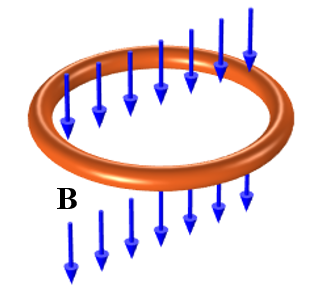- 8.1: Comparison of Static and Time-Varying Electromagnetics
- Maxwell’s Equations in the general (time-varying) case include extra terms that do not appear in the equations describing electrostatics and magnetostatics. These terms involve time derivatives of fields and describe coupling between electric and magnetic fields.
- 8.2: Electromagnetic Induction
- When an electrically-conducting structure is exposed to a time-varying magnetic field, an electrical potential difference is induced across the structure. This phenomenon is known as electromagnetic induction. A convenient introduction to electromagnetic induction is provided by Lenz’s Law. This section explains electromagnetic induction in the context of Lenz’s Law and provides two examples.
- 8.3: Faraday’s Law
- Faraday’s Law describes the generation of electric potential by a time-varying magnetic flux. This is a form of electromagnetic induction.
- 8.4: Induction in a Motionless Loop
- In this section, we consider the problem with a single motionless loop of wire in the presence of a spatially-uniform but time-varying magnetic field. A small gap is introduced in the loop, allowing us to measure the induced potential VT . Additionally, a resistance R is connected across VT in order to allow a current to flow. This problem was considered as an introduction to Faraday’s Law; in this section, we shall actually work the problem and calculate some values.
- 8.5: Transformers - Principle of Operation
- A transformer is a device that connects two electrical circuits through a shared magnetic field. Transformers are used in impedance transformation, voltage level conversion, circuit isolation, conversion between single-ended and differential signal modes, and other applications.1 The underlying electromagnetic principle is Faraday’s Law – in particular, transformer emf.
- 8.6: Transformers as Two-Port Devices
- We shall now consider ratios of current and impedance in ideal transformers, using the two-port model.
- 8.7: The Electric Generator
- A generator is a device that transforms mechanical energy into electrical energy, typically by electromagnetic induction via Faraday’s Law. For example, a generator might consist of a gasoline engine that turns a crankshaft to which is attached a system of coils and/or magnets. This rotation changes the relative orientations of the coils with respect to the magnetic field in a time-varying manner, resulting in a time-varying magnetic flux and subsequently induced electric potential.
- 8.8: The Maxwell-Faraday Equation
- In this section, we generalize Kirchoff’s Voltage Law, previously encountered as a principle of electrostatics, which states that in the absence of a time-varying magnetic flux, the electric potential accumulated by traversing a closed path C is zero.
- 8.9: Displacement Current and Ampere’s Law
- In this section, we generalize Ampere’s Law, previously encountered as a principle of magnetostatics. We shall now demonstrate that this equation is unreliable if the current is not steady; i.e., not DC.
Time Varying Magnetic Fields Cause
Circuit theory is applied in the determination of the time-varying axial magnetic field produced by the interaction of a vibrating aluminum enclosure and the earth’s magnetic field. The axial magnetic field that exists within the enclosure is received by a loop antenna. A steady-state time-harmonic analysis is applied. View Time Varying Fields.pdf from SOFTWARE E 305 at European University of Lefke.


